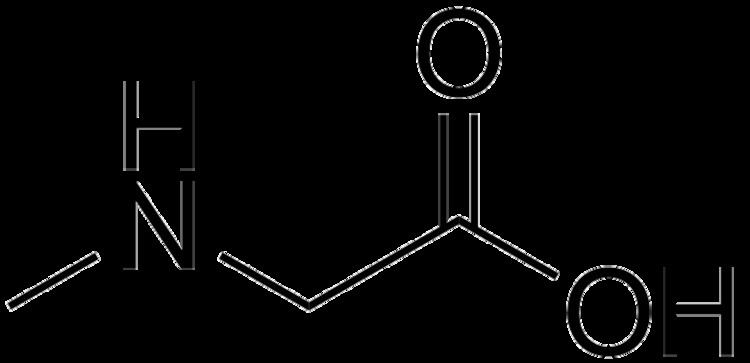3DMet B01190 Formula C3H7NO2 Appearance White crystalline powder | Related compounds Molar mass 89.093 g/mol | |
 | ||
Related alkanoic acids | ||
Sarcosine
Sarcosine, also known as N-methylglycine, is an intermediate and byproduct in glycine synthesis and degradation. Sarcosine is metabolized to glycine by the enzyme sarcosine dehydrogenase, while glycine-N-methyl transferase generates sarcosine from glycine. Sarcosine is an amino acid derivative that is naturally found in muscles and other body tissues. In the laboratory, it may be synthesized from chloroacetic acid and methylamine. Sarcosine is found naturally as an intermediate in the metabolism of choline to glycine. Sarcosine is sweet to the taste and dissolves in water. It is used in manufacturing biodegradable surfactants and toothpastes as well as in other applications.
Contents
Sarcosine is ubiquitous in biological materials and is present in such foods as egg yolks, turkey, ham, vegetables, legumes, etc.
Sarcosine is formed from dietary intake of choline and from the metabolism of methionine, and is rapidly degraded to glycine, which, in addition to its importance as a constituent of protein, plays a significant role in various physiological processes as a prime metabolic source of components of living cells such as glutathione, creatine, purines and serine. The concentration of sarcosine in blood serum of normal human subjects is 1.4 ± 0.6 micromolar.
Clinical significance
Sarcosine has no known toxicity, as evidenced by the lack of phenotypic manifestations of sarcosinemia, an inborn error of sarcosine metabolism. Sarcosinemia can result from severe folate deficiency because of the folate requirement for the conversion of sarcosine to glycine.
Schizophrenia
Recently, sarcosine has been investigated in relation to the mental illness schizophrenia. Early evidence suggests that intake of 2 g/day sarcosine as add-on therapy to certain antipsychotics (not clozapine) in schizophrenia gives significant additional reductions in both positive and negative symptomatology as well as the neurocognitive and general psychopathological symptoms that are common to the illness. Sarcosine had been tolerated well. It is also under investigation for the possible prevention of schizophrenic illness during the prodromal stage of the disease. It acts as a type 1 glycine transporter inhibitor and a glycine agonist. It increases glycine concentrations in the brain thus causing increased NMDA receptor activation and a reduction in symptoms. As such, it might be an interesting treatment option and a possible new direction in the treatment of the mental illness in the future. A 2011 meta-analysis found adjunctive sarcosine to have a medium effect size for negative and total symptoms.
Depression
Major depressive disorder is a complex disease and most currently available antidepressants aiming at monoamine neurotransmission exhibit limited efficacy and cognitive effects. N-methyl-D-aspartate (NMDA), one subtype of glutamate receptors, plays an important role in learning and memory. N-methyl-D-aspartic acid (NMDA) enhancing agents, such as Sarcosine (N-methylglycine), have been used as adjunctive therapy of schizophrenia. Preliminary clinic trials indicated that intake of Sarcosine improved not only psychotic but also depressive symptoms in patients with schizophrenia.
A clinical study showed Sarcosine to be significantly more effective in treating Major Depression (substantially improved scores on the Hamilton Depression Rating Scale, Clinical Global Impression, and Global Assessment of Function) than Citalopram over a 6-week period. Sarcosine-treated patients were much more likely and quicker to remit and less likely to drop out of the study. Sarcosine was well tolerated without significant side effects.
Prostate cancer marker
In a paper published in the journal Nature in 2009, sarcosine was reported to activate prostate cancer cells and to indicate the malignancy of prostate cancer cells when measured in urine. Sarcosine was identified as a differential metabolite that was greatly increased during prostate cancer progression to metastasis and could be detected in urine. Sarcosine levels seemed to control the invasiveness of the cancer.
However, this conclusion has been disputed. A German research team reported a different result in 2010. After measuring sarcosine levels in urine samples from prostate cancer patients, they concluded that measuring sarcosine in urine fails as a marker in prostate cancer detection and identification of aggressive tumors. In addition, another report concluded that serum sarcosine is not a marker for prostate cancer. A review of the literature reached a similar conclusion.
History
Sarcosine was first isolated and named by the German chemist Justus von Liebig in 1847, while Jacob Volhard first synthesized it in 1862.
Volhard successfully synthesized the compound while working in the lab of Hermann Kolbe. Prior to the synthesis of sarcosine, it had long been known to be hydrolysis product of creatine, a compound found in meat extract. Under this assumption, Volhard proposed that sarcosine was N-methylglycine, and proved so by preparing the compound with methylamine and monochloroacetic acid.
